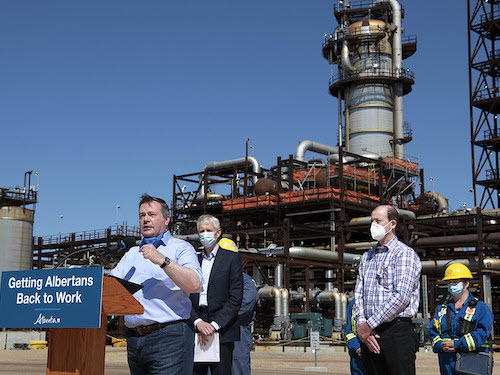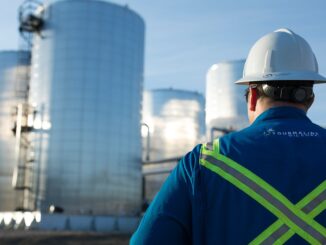
A new federal incentive, modelled on a U.S. tax credit for carbon capture, utilization and storage, would be tailor-made to drive higher greenhouse gas emissions and could produce unexpected surprises for private investors if it’s included in Finance Minister Chrystia Freeland’s April 19 budget, a veteran U.S. energy consultant and attorney has told The Energy Mix.
The fossil industry and its allies have been intensifying their push for carbon capture (CCUS) subsidies, with Alberta Premier Jason Kenney calling for C$30 billion in federal largesse over 10 years. In an email Tuesday, Ian Cameron, press secretary to Natural Resources Minister Seamus O’Regan, said carbon capture technology “creates jobs, lowers emissions, and increases our competitiveness. It’s an important part of our government’s plan to get to net-zero emissions by 2050 and we are working with all provinces, including Alberta, to keep Canada at the forefront of this promising technology.”
But the signature tax measure that is generating much of the hype, the Section 45Q tax credit [pdf] named for the relevant section of the U.S. Internal Revenue Code, creates an incentive for power plant operators to emit more carbon, while giving investors a false picture of projects’ viability, said David Schlissel, a Massachusetts-based consultant associated with the Institute for Energy Economics and Financial Analysis (IEEFA).
“The oil industry and the coal industry see this as a way to keep their industries going,” Schlissel told The Mix. “So they green-wrap it as a way to save produced CO2.” But the economics of those failing power plants, coupled with a volume-based tax credit that pays up to US$50 per tonne for any carbon an operator can capture, turn Section 45Q into an incentive to burn and emit more carbon, not less.
Schlissel cited the example of the San Juan generating station, a coal plant in New Mexico that was to be propped up by adding a carbon capture unit, but that the local utility has been trying hard to shut down. The plant had been operating about 63% of the time. But to generate enough carbon credits for the project to pay for itself, it would have needed an 85% capacity factor. “In order to capture more CO2, they have to run more to produce more CO2,” he said, when “the whole purpose of this endeavour is supposed to be to reduce emissions.”
The other problem was the real-life efficiency of a CCUS unit that was supposed to capture 90% of the carbon the plant produced, but was more likely to secure about 80%—which would still be better than Sask Power’s ill-fated Boundary Dam CCUS project in Saskatchewan, where he said successful carbon capture amounted to 65% of the original plan. With lower power output and less carbon capture than project developers promised, the San Juan plant looked likely to take in far less tax credit revenue than advertised—which meant broken promises and potential financial risk for investors.
That’s a big problem, Schlissel added, since one of the main purposes of a tax credit is to “de-risk” a project for its private backers. “Investors wouldn’t do this if they had to pay for it themselves,” he told The Mix.
Paying Billions for Higher Emissions
Schlissel was just as skeptical about CCUS credits for Enhanced Oil Recovery (EOR), where captured carbon is pumped underground to extend the life of aging oil wells. It’s the method of choice for carbon capture operations in Saskatchewan and Alberta, and one of the most likely uses for a federal carbon capture tax credit.
“If the carbon is used for EOR, you’re producing more CO2 by producing even more oil,” he said. “You’ve got to divorce carbon capture from Enhanced Oil Recovery, because that just compounds the problem.”
Earlier this month, Toronto-based Environmental Defence wrote to Freeland and three other cabinet ministers, urging them to reject subsidies for enhanced oil production in this year’s budget. The letter’s 47 signatories represented two million people across Canada, Environmental Defence said. [Disclosure: Energy Mix Productions was one of the signatories.]
The letter took specific aim at the attempts to secure a 45Q-style tax credit in Canada. (It placed the value of the credit at US$35 per tonne, not $50 as quoted by IEEFA.)
“Despite a veneer of green, such a tax credit could result in a significant amount of foregone revenue and enable the production of more carbon than is captured,” the letter stated. “Since the overall incentive for power plants and industrial facilities to sell captured CO2 to oil companies for use in extraction would be more lucrative than the incentive for facilities to directly sequester their carbon pollution, this measure would primarily incentivize oil extraction. In fact, oil companies are looking to EOR to expand production—and the biggest expense in EOR operations is the CO2.”
Citing a 2017 analysis [pdf] by Oil Change International, the Environmental Defence letter said the U.S. credit “could result in at least an additional 400,000 barrels per day of CO2-enhanced oil production in the United States in 2035, which would directly lead to as much as 50.7 million tonnes of net CO2 emissions annually—and possibly far more. The portion of the bill that benefits the oil industry alone could cost American taxpayers as much as US$2.8 billion every year.”
Julia Levin, Environmental Defence’s climate and energy program manager, said the connection back to Enhanced Oil Recovery should be enough to disqualify a new carbon capture tax credit in Freeland’s budget. With more than 80% of the world’s captured carbon used to extract more oil, “it’s carbon-positive,” she said. “No one should be behind this,” because “no one should be behind production subsidies anymore. Even when our minister talks about subsidies, he agrees there should be no subsidies for the production of oil and gas.”
The 0.1% Solution
The critical analysis on both sides of the border presents a distinctly different view from the “strong consensus” reached by the Energy Future Forum, a multistakeholder panel convened by the Ottawa-based Public Policy Forum to seek an “achievable pathway to national climate and economic objectives”. That pathway, the EFF says, “must include a significant contribution from carbon capture technologies and from utilization and storage.”
Despite the severe stumbles Schlissel details in the U.S., the high cost and disappointing performance of Boundary Dam, and the low capacity and slow start-up of CCUS projects world-wide, the EFF bravely imagines the technology as a part of Canada’s 2030 short-term emissions reduction target. “If Canada is going to meet its 2030 climate change objectives and establish a plan to achieve net-zero carbon emissions by 2050, carbon capture, utilization and storage (CCUS), including direct air capture (DAC) and other developing technologies, will play an integral role,” the forum states.
Two months ago, the UK’s Tyndall Centre for Climate Change Research placed the operational capacity of CCUS projects around the world at just 39 megatonnes of CO2 per year, or roughly 0.1% of global annual emissions, with deployment slow and plagued by accidents. Tyndall reported 81% of the captured carbon was being used to extract more oil via EOR.
An eight-page consensus paper [pdf] produced by the Energy Future Forum points to Boundary Dam, along with a second CCUS plant at the Shell Quest heavy oil upgrader in Alberta, as success stories that each capture roughly one megatonne of carbon per year—a bit less at Boundary Dam, a bit more at Shell Quest. All it took to get the Shell Quest operation up and running was combined federal and provincial subsidies of C$865 million, and Environmental Defence’s Levin put total Canadian CCUS subsidies to date at $2 billion. [Which surely wouldn’t have cut nearly as much carbon or created nearly as many jobs if it had been invested in, say, a mass, deep energy retrofit program [pdf]—Ed.]
A third project, the Alberta Carbon Trunk Line (ACTL), has capacity to transmit 14.6 megatonnes of captured CO2 per year from a refinery, a fertilizer plant, and other industries in Edmonton for use in an EOR facility, the EFF says. And Canadian Natural Resources Ltd.’s Horizon tar sands/oil sands plant is capturing 438,000 tonnes per year.
“Each of these projects proves CCUS technology is available and commercially viable with the right incentives,” the report states. The EFF calls for Canada to “level the playing field” and support CCUS with “stackable federal and provincial tax credits” to “spur innovation and make investments competitive with those available in the United States and elsewhere.”
The forum cites a 90% capture rate for CCUS plants, in contrast to Schlissel’s assertion that the technology often fails to perform as intended.
Hard-to-Decarbonize Industries
The EFF names hard-to-decarbonize sectors like cement and steel, where carbon capture may be one of the options to keep essential industries going in a decarbonizing world. And it points to fossil companies (and others) investing in direct air capture technologies that aren’t attached to fossil extraction, and might be able to draw down some of the emissions that have been pouring into the atmosphere since the dawn of the industrial age.
Schlissel gives that line of thinking mixed reviews.
“Right now, I’m agnostic about carbon capture for industrial uses,” including oil, he said. “And while I have serious doubts about carbon capture from gas plants, I think it should be studied.”
But Schlissel did cite other analysts’ concerns about the sheer volume of (presumably renewable) energy it would take to run DAC installations at scale, and pointed to a more basic problem with the way low-carbon pathways are too often framed.
“Everybody tries to avoid the simple solution,” he told The Mix. “Stop producing the crap. Start with energy efficiency, renewables, storage. I imagine we’ll have to run some gas for decades in some places, not a lot of gas, but I accept there will be some. Then let the planet heal. Don’t sink billions and billions into these new technologies, whether it’s carbon capture or small modular reactors, that are going to take a long time to build and to prove that they’re effective.”
The other question is how long it will take for that proof to accumulate—against the 2050 deadline in the UN’s 1.5°C pathways report, much less the 2030 target in the EFF’s sights. Scenario modelling reported in yesterday’s Bloomberg Green newsletter showed that the most promising new emissions reduction innovation would only have a limited impact on the climate crisis if it were introduced today, given the time it would take to scale up.
“It might take a decade to bring this zero-carbon miracle to market, and the better part of another decade to design and build plants,” explained columnist Eric Roston. “What’s worse is this: in the time it takes the new industry to grow, coal and gas plants will continue to be built and last 30 years or more. Even with [nuclear] fusion tomorrow, we’d make it to 2050 without retiring much of the CO2-spewing infrastructure that needs replacement yesterday.”
For the rest of the story: The Energy Mix.



